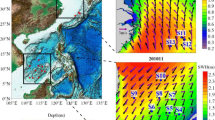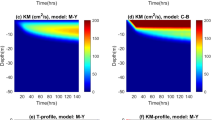Abstract
In this investigation, the General Ocean Turbulent Model (GOTM) was used for the investigation of turbulent processes of a water column over a study site in the Oman Sea. The used method appropriately reproduces the main features of the study area, allows for a realistic view of the turbulence, and thus makes it possible to compare the Mixed Layer Depth (MLD) in all seasons. The MLD varies from 150 m in spring to 200 m in autumn. This simulation presented that the production of Turbulent Kinetic Energy (TKE) in the seawater column in the Oman Sea has seasonal changes. In the surface layer, TKE is small which is produced by low quantities of shear production, then it is conserved by the wind stress on the mixed layer and buoyancy production. In the deep layer, TKE is produced only by buoyancy. Calculated Prandtl number in all seasons presented that the turbulent diffusivity of temperature is dominant in most parts of water column, except in a thin layer which forms approximately between the depths of 150–200 m.













Similar content being viewed by others
REFERENCES
Bonino, G., Iovino, D., and Masina, S., Ocean sensitivity to bulk formulae parameterization: a NEMO-ORCA025 model study, 2020, vol. 22, p. 9591.
Boodhraj, K., Vichi, M., and Smit, J.E., An assessment of the role of the k–ε vertical mixing scheme in the simulation of Southern Ocean upper dynamics, South Afr. Soc. For., p. 6.
Brasseur, J.G. and Wei, T., Designing large-eddy simulation of the turbulent boundary layer to capture law-of-the-wall scaling, Phys. Fluids, 2010, vol. 22, 021303.
Brown, J., Application of POLCOMS Model to Liverpool Bay Residual Currents, 2017.
Bruggeman, J. and Bolding, K., A general framework for aquatic biogeochemical models, Environ. Model. Softw., 2014, vol. 61, pp. 249–265.
Brumer, S.E., Garnier, V., Redelsperger J.-L., Bouin, M.-N., Ardhuin, F., and Accensi, M., Impacts of surface gravity waves on a tidal front: a coupled model perspective, Ocean Model, 2020, vol. 154, 101677.
Burchard, H. and Bolding, K., Comparative analysis of four second-moment turbulence closure models for the oceanic mixed layer, J. Phys. Oceanogr., 2001, vol. 31, pp. 1943–1968.
Canuto, V.M., Howard, A., Cheng, Y., and Dubovikov, M.S., Ocean turbulence. Part I: One-point closure model—Momentum and heat vertical diffusivities, J. Phys. Oceanogr., 2001, vol. 31, pp. 1413–1426.
Carton, J.A., Chepurin, G.A., Chen, L., and Grodsky, S.A., Improved global net surface heat flux, J. Geophys. Res.: Oceans, 2018, vol. 123, pp. 3144–3163.
Cheng, N.-S. and Law, A.W.-K., Measurements of turbulence generated by oscillating grid. J. Hydraul. Eng., 2001, vol. 127, pp. 201–208.
Fairall, C.W., Bradley, E.F., Hare, J.E., Grachev, A.A., and Edson, J.B., Bulk parameterization of air–sea fluxes: updates and verification for the COARE Algorithm, J. Clim., 2003, vol. 16, pp. 571–591.
Fodor, K., Mellado, J.P., and Wilczek, M., On the role of large-scale updrafts and downdrafts in deviations from Monin–Obukhov similarity theory in free convection, Bound.-Layer Meteorol., 2019, vol. 172, pp. 371–396.
Foken, T., 50 years of the Monin–Obukhov similarity theory, Bound-Layer Meteorol., 2006, vol. 119, pp. 431–447.
Frederickson, P.A., Davidson, K.L., Zeisse, C.R., and Bendall, C.S., Estimating the refractive index structure parameter over the ocean using bulk methods, J. Appl. Meteorol., 2000, vol. 39, pp. 1770–1783.
Hallberg, R., The ability of large-scale ocean models to accept parameterizations of boundary mixing, and a description of a refined bulk mixed-layer model, Proceedings of the 2003 Aha Hulikoa Hawaiian Winter Workshop, 2003, pp. 187–203.
Hanert, E., Deleersnijder, E., and Legat, V., An adaptive finite element water column model using the Mellor–Yamada level 2.5 turbulence closure scheme, Ocean Model., 2006, vol. 12, pp. 205–223.
Hyun-Chae, J., Byung-Kwon, M., Wie, J., Park, H.-S., Lee, J., and Young-Hwa, B., A single-column ocean biogeochemistry model (GOTM–TOPAZ) version 1.0, Geosci. Model Dev., 2019, vol. 12, pp. 699–722.
Kalra, T.S., Li, X., Warner, J.C., Geyer, W.R., and Wu, H., Comparison of physical to numerical mixing with different tracer advection schemes in estuarine environments, J. Mar. Sci. Eng., vol. 2019, vol. 7, p. 338.
Khademi, I., Akbarinasab, M., Bidokhti, A.A., and Khalilabadi, M.R., Numerical calculation of Prandtl number in the stratification of water column of the Hormuz Strait, J. Mar. Sci. Technol., 2017, vol. 16 pp. 14–26.
Khalilabadi, M.R., 3D modeling of circulation in the Oman sea using the MITgcm model, Hydrophysycs, 2016, vol. 2, no. 2, pp. 61–68.
Khalilabadi, M.R., The effect of meteorological events on sea surface height variations along the northwestern Persian Gulf, Curr. Sci., 2016, vol. 110, no. 11, pp. 2138–2141.
Khalilabadi, M.R. and Hassantabar, B.S.H., Investigation of magnetic field fluctuations due to sea waves in the Strait of Hormuz, IJCOE, 2016 vol. 8, No. 1, pp. 10–15.
Khalilabadi, M.R.K., Ashkezari GD, and Derakhshan, P., Modeling Marine Currents in the Gulf of Oman using the Mike3D Model, J. Environ. Sci. Studies (JESS), 2020, vol. 5, pp. 2404–2412.
Kim, S.B., Yamaguchi, K., Kondo, A., and Soda S., A comparative study of the Mellor–Yamada and k–ε two-equation turbulence models in atmospheric application, J. Wind. Eng. Ind. Aerodyn., 2003, vol. 91, pp. 791–806.
Klocker, A. and McDougall, T.J., Influence of the nonlinear equation of state on global estimates of dianeutral advection and diffusion, J. Phys. Oceanogr., 2010, vol. 40, pp. 1690–709.
van der Laan, M.P., Kelly, M.C., and Sørensen, N.N., A new k-epsilon model consistent with Monin–Obukhov similarity theory, Wind Energy, 2017, vol. 20, pp. 479–89.
Lai, A.C., Law, A.W.-K., and Adams, E.E., A second-order integral model for buoyant jets with background homogeneous and isotropic turbulence, J. Fluid. Mech., 2019, vol. 871, pp. 271–304.
Liu, J., Lu, S., and Li, Y., Numerical study on sensibility of turbulence closure schemes at Oujiang River Estuary, Appl. Ocean Res., 2019, vol. 88, pp. 76–88.
Luneva, M.V., Wakelin, S., Holt, J.T., Inall, M.E., Kozlov, I.E., Palmer, M.R., et al., Challenging vertical turbulence mixing schemes in a tidally energetic environment: 1. 3-D shelf-sea model assessment, J. Geophys Res. Oceans, 2019, vol. 124, pp. 6360–6387.
Ma, L., Wang, B., and Zhang, X., Impact of seawater equation of state on the simulation of Atlantic Meridional Overturning Circulation, Clim. Dyn., 2020, vol. 54, pp. 1161–1178.
Madec, G., Bourdallé-Badie, R., Bouttier, P.-A., Bricaud, C., Bruciaferri, D., Calvert, D., et al., NEMO Ocean Engine, 2017.
Maity, S. and Warrior, H., Reynolds stress anisotropy based turbulent eddy viscosity model applied to numerical ocean models, J. Fluids Eng., 2011, vol. 133.
Mallick, S.K., Agarwal, N., Sharma, R., Prasad, K., and Ramakrishna, S., Thermodynamic response of a high-resolution Tropical Indian Ocean Model to TOGA COARE Bulk Air–Sea Flux parameterization: case study for the Bay of Bengal (BoB), Pure Appl. Geophys., 2020, pp. 1–20.
Millero, F.J., History of the equation of state of seawater, Oceanography, 2010, vol. 23, pp. 18–33.
Mohammadi-Aragh, M., Klingbeil, K., Brüggemann, N., Eden, C., and Burchard, H., The impact of advection schemes on restratifiction due to lateral shear and baroclinic instabilities, Ocean Model., 2015, vol. 94, pp. 112–127.
Mollaesmaeilpour, S., Mohammad, M.M., Hasanzadeh, E., and Khalilabadi, M.R., 3D Modeling of wind-driven circulation in the Northern Indian Ocean during monsoon, J. Oceanogr., 2019, vol. 10, no. 38, pp. 17–28.
Mollaesmaeilpour, S., Mohammad, M.M., Hassanzadeh, S., and Khalilabadi, M.R., The study of hydrophysical properties of the Northern Arabian Sea during monsoon: a numerical study, Hydrophis., 2019, vol. 5, no. 8, pp. 47–59.
Nakajima, K., Ooka, R., and Kikumoto, H., Evaluation of k-ε Reynolds stress modeling in an idealized urban canyon using LES, J. Wind. Eng. Ind. Aerodyn., 2018, vol. 175, pp. 213–28.
Optis, M., Monahan, A., and Bosveld, F.C., Moving beyond Monin–Obukhov similarity theory in modelling wind-speed profiles in the lower atmospheric boundary layer under stable stratification, Bound.-Layer Meteorol., 2014, vol. 153, pp. 497–514.
Perez, L., Cossu, R., Grinham, A., and Penesis, I., Evaluation of wave-turbulence decomposition methods applied to experimental wave and grid-generated turbulence data, Ocean. Eng., 2020, vol. 218, 108186.
Sasmal, K., Maity, S., and Warrior, H.V., On the application of a new formulation of nonlinear eddy viscosity based on anisotropy to numerical ocean models, J. Turbul., 2014, vol. 15, pp. 516–539.
Sukoriansky, S., Galperin, B., and Perov, V., Application of a new spectral theory of stably stratified turbulence to the atmospheric boundary layer over sea ice, Bound-Layer Meteorol., 2005, vol. 117, pp. 231–257.
Thomas, S., Babanin, A.V., Walsh, K.J., Stoney, L., and Heil, P., Effect of wave-induced mixing on Antarctic Sea ice in a high-resolution ocean model, Ocean Dyn., 2019, vol. 69, pp. 737–746.
Umlauf, L., Burchard, H., and Hutter, K., Extending the k–ω turbulence model towards oceanic applications, Ocean Model., 2003, vol. 5, pp. 195–218.
Umlauf, L. and Burchard, H., Second-order turbulence closure models for geophysical boundary layers. A review of recent work, Cont. Shelf. Res., 2005, vol. 25, pp. 795–827.
Umlauf, L., Burchard, H., and Bolding, K., GOTM: Source Code and Test Case Documentation, Devel Version-Pre, 2006, vol. 4.
Vigdorovich, I., A law of the wall for turbulent boundary layers with suction: Stevenson’s formula revisited, Phys. Fluids, 2016, vol. 28, 085102.
Warner, J.C., Sherwood, C.R, Arango, H.G., and Signell, R.P., Performance of four turbulence closure models implemented using a generic length scale method, Ocean Model., 2005, vol. 8, pp. 81–113.
Webster, D.R., Brathwaite, A., and Yen, J., A novel laboratory apparatus for simulating isotropic oceanic turbulence at low Reynolds number, Limnol. Oceanogr. Methods, 2004, vol. 2, pp. 1–12.
Xiao, Q., Tsai, H.-M., and Liu, F., Computation of turbulent separated nozzle flow by a lag model, J. Propuls. Power, 2005, vol. 21, pp. 368–371.
Xu, H., Further Improvements to a Single-column Ocean Model, 2017.
Xu, H. and Pimentel, S., Improvements to a Single-Column Ocean Model, 2016.
Zeng, X. and Wang, Y., A k–ε Turbulence Model for the Convective Atmosphere, J. Atmospheric Sci., 2020, vol. 77, pp. 3891–3906.
General Ocean Turbulence Model, https://gotm.net/.
European Centre for Medium-Range Weather Forecasts, https://www.ecmwf.int/.
Funding
This work was supported by ongoing institutional funding. No additional grants to carry out or direct this particular research were obtained.
Author information
Authors and Affiliations
Corresponding author
Ethics declarations
The authors of this work declare that they have no conflicts of interest.
Additional information
Publisher’s Note.
Pleiades Publishing remains neutral with regard to jurisdictional claims in published maps and institutional affiliations.
Rights and permissions
About this article
Cite this article
Mohammad Reza Khalilabadi Turbulent Processes in the Oman Sea: A Numerical Study. Water Resour 51, 98–109 (2024). https://doi.org/10.1134/S0097807823600717
Received:
Revised:
Accepted:
Published:
Issue Date:
DOI: https://doi.org/10.1134/S0097807823600717




